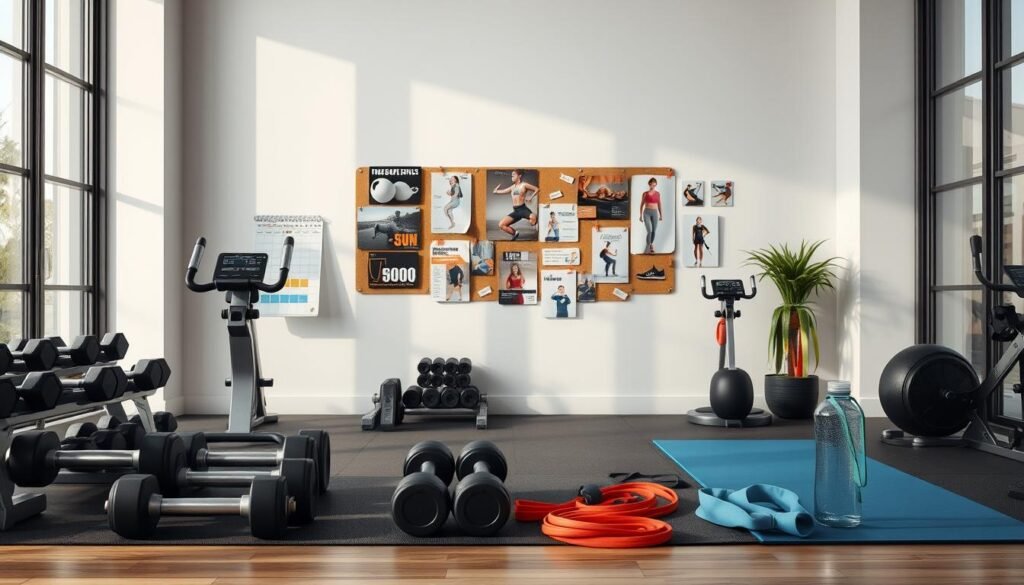Welcome to the ultimate guide on achieving fitness goals! This guide is packed with expert tips and innovative workout strategies. It’s made for anyone wanting to improve their health and well-being.
We cover effective workout routines and essential nutritional advice. With these tools, you’re set for a successful fitness journey. Whether you’re starting out or refining your regimen, this is your source. It’s all about achieving fitness and becoming your healthiest self.
Key Takeaways
- Understand the various fitness goals to tailor your strategy.
- Create effective workout routines that fit your objectives.
- Recognize the importance of nutrition in reaching your fitness goals.
- Set realistic expectations and track your progress.
- Incorporate meal planning to support your fitness journey.
- Leverage proven weight loss strategies, including a caloric deficit.
- Utilize muscle-building techniques relevant to your experience level.
Understanding Your Fitness Goals
Starting your fitness journey needs clear goals. It’s how you measure success and keep motivated. Knowing what you want to achieve helps make a plan that works for you.
Types of Fitness Goals
People choose fitness goals based on what they want and what they can do. Knowing the different kinds of fitness goals is key. This knowledge helps build a complete fitness plan. Here are some key areas:
- Weight Loss
- Muscle Gain
- Improving Endurance
- Enhancing Flexibility
Mixing your fitness goals with what you like makes it more fun. Setting clear, possible goals boosts your drive. This keeps you moving forward.
Experts say to think about why you’re doing this and what you want to achieve. Knowing yourself leads to a rewarding journey. It sets a clear path and keeps you excited along the way.
| Type of Fitness Goal | Description | Key Focus Areas |
|---|---|---|
| Weight Loss | Aiming to decrease body weight through diet and exercise. | Caloric intake, cardiovascular workouts. |
| Muscle Gain | Focusing on increasing muscle size and strength. | Resistance training, protein intake. |
| Improving Endurance | Enhancing stamina for prolonged physical activities. | Aerobic exercises, gradual intensity increase. |
| Enhancing Flexibility | Increasing the range of motion in joints and muscles. | Stretching routines, yoga practices. |
Creating Effective Workout Routines
Making good workout plans is crucial for achieving fitness goals. To get the best results, workouts should be made to fit each person’s aims, how fit they are, and what they have to work with. Mixing cardiovascular, strength, and flexibility exercises helps create a well-rounded fitness routine.
Tailoring Workouts to Your Goals
To make a workout plan that’s just for you, think about:
- Fitness Level: Know your starting point and plan your workouts to match.
- Available Equipment: Use whatever you have, like weights, machines, or just your body.
- Time Constraints: Set aside enough time for each workout to stay on track.
Good workout plans use different techniques. High-Intensity Interval Training (HIIT) is great for quick results. Strength training builds up muscles, and yoga helps with flexibility and recovery. To keep improving, try cross-training to vary your routine and work different muscles.
Learning about effective workout routines is useful. Keep track of your progress and make changes when needed. This helps you continue to improve.
Nutrition Essentials for Your Fitness Journey
Feeding your body right is key to reaching your fitness goals. Knowing about macronutrients is central to planning your diet. Proteins, carbohydrates, and fats each play a unique role. They are all needed for you to perform well and recover.
The Role of Macronutrients
Proteins help fix and grow muscles. If you’re active, eating more protein helps you recover after workouts. Good sources are lean meats, legumes, and dairy.
Carbs are your main fuel during exercise. They refill your energy stores, which is vital for lasting energy. Eat foods high in complex carbs like whole grains and fruits. This way, you get energy and fiber.
Fats might be ignored, but they’re crucial. They help your body absorb nutrients and provide energy. Eating healthy fats from avocados, nuts, and fish keeps your diet balanced. This helps you stay on track with fitness.
Planning your meals helps a lot with fitness nutrition. If you prepare balanced meals ahead, you’ll always have good food ready. This stops you from choosing unhealthy options when you’re busy. Also, don’t forget to drink water. Staying hydrated is very important for your performance. Drink plenty of water before, during, and after your workouts to help you recover.
| Macronutrient | Function | Recommended Sources |
|---|---|---|
| Proteins | Repairs and builds muscle | Chicken, fish, legumes, eggs |
| Carbohydrates | Provides energy | Brown rice, oats, quinoa, fruits |
| Fats | Aids nutrient absorption | Nuts, seeds, olive oil, avocados |
Fitness Goals: Setting Realistic Expectations
It’s key in fitness to set goals that are real and doable. Knowing what you can and can’t do helps set good goals. This keeps you driven and saves you from feeling let down.
The Importance of Progress Tracking
Tracking goals is crucial on your fitness path. Keeping tabs on your wins boosts responsibility and shows how far you’ve come. Here are a few ways to track your progress:
- Maintaining a fitness journal
- Using fitness apps like MyFitnessPal or Fitbit
- Taking regular progress photos
- Setting weekly or monthly milestones
Celebrating small wins is key for sticking to it, research shows. By watching your progress, you can tweak your routine to keep moving toward your fitness goals.

Using these methods helps keep your drive alive on this journey. It ensures your goals match what you can do. Track your progress to stay on path and enjoy reaching your fitness targets.
| Progress Tracking Method | Benefits | Tools Available |
|---|---|---|
| Fitness Journal | Personal reflection and self-awareness | Notebook or digital journaling apps |
| Fitness Apps | Convenience and analytics | MyFitnessPal, Fitbit |
| Progress Photos | Visual motivation | Smartphone or camera |
| Milestones | Structured goals | Calendar or goal-setting apps |
Changing up how you track goals can help you push past any standstill. Embrace the fitness path with clear purpose. Focus on your own progress to reach your health dreams.
Incorporating Healthy Diet Plans
Adding healthy diet plans to your life boosts your fitness journey. Planning your meals helps reach dietary goals that match your exercises. By making balanced meal plans, you ease daily food decisions and meet fitness nutrition goals.
Meal Planning Strategies
For better meal planning, prefer whole foods and avoid processed stuff. Here are some tips:
- Set Clear Goals: Choose your nutrition goals, like losing weight, gaining muscle, or improving health.
- Weekly Planning: Spend time each week to plan your meals. Make sure they include different food groups.
- Batch Preparation: Cook in bulk to save time on busy days. This keeps your diet on track.
- Smart Shopping: Make a grocery list from your meal plan. This stops unplanned purchases and ensures you have what you need.
- Portion Control: Split meals into right sizes to prevent overeating and keep your diet balanced.
Following dietary guidelines, like MyPlate’s, is key for healthy habits. These guides help you make balanced meals for fitness nutrition and well-being.
Weight Loss Strategies That Work
Learning about strong weight loss methods is key for those wanting to lose weight. The main idea is the caloric deficit, meaning you eat fewer calories than you use. This part talks about different ways to lose weight effectively and keep it off for good.
Understanding Caloric Deficit
To create a caloric deficit, you need to change your daily habits. This means eating less and moving more. Here’s what you can try:
- Portion Control: Limit the size of your meals to cut down on calories.
- Mindful Eating: Pay attention when you eat. This helps stop overeating and makes meals more enjoyable.
- Increased Physical Activity: Exercise helps burn off calories and is good for your health.
Using these strategies can help you keep up a caloric deficit over time. Try mixing these methods for the best results. Success stories show how little changes can lead to big improvements in your life.
| Weight Loss Strategy | Description | Benefits |
|---|---|---|
| Portion Control | Limiting serving sizes to manage caloric intake. | Helps reduce total calorie consumption without sacrificing satisfaction. |
| Mindful Eating | Paying attention to hunger and fullness cues. | Encourages healthier food choices and reduces cravings. |
| Increased Physical Activity | Incorporating exercise into daily routines. | Boosts metabolism and aids in calorie burning. |

Muscle Building Techniques for All Levels
Building muscle is a unique journey for everyone. It is essential to know powerful muscle building strategies to get the results you want. One key way to grow muscles is called progressive overload. This means slowly increasing the challenge in your strength training. It helps muscles get stronger and grow over time.
Progressive Overload Methods
There are many ways to make your training harder and more effective. Let’s look at some common strategies:
- Increasing Weight: A basic way to apply progressive overload is to slowly add more weight to your lifts.
- Adding Repetitions: You can also do more reps with the same weight as before.
- Enhancing Time Under Tension: Making the lifting phase of exercises slower increases the challenge without needing more weight.
- Changing the Tempo: Using different speeds in your exercises can push your muscles to adapt.
- Varying Exercises: Trying new exercises keeps your muscles working hard and avoids plateaus.
Using different tools like free weights, resistance bands, and your own body weight makes workouts exciting. This variety means everyone can find a way to strength train that they enjoy.
Remember, taking breaks for your muscles to heal is as crucial as the workout itself. Rest helps avoid injuries and is key to getting stronger and building muscle.
| Progressive Overload Method | Description | Benefits |
|---|---|---|
| Increasing Weight | Gradually add weight to your lifts. | Stimulates muscle growth and increases strength. |
| Adding Repetitions | Perform more reps with the same weight. | Improves endurance and promotes hypertrophy. |
| Enhancing Time Under Tension | Slow down the tempo of lifts. | Increases muscle fiber activation and connects with strength. |
| Changing the Tempo | Vary the speed of repetitions. | Creates a new stimulus for muscle adaptation. |
| Varying Exercises | Introduce new exercises regularly. | Prevents plateaus and enhances overall muscle development. |
Staying Motivated: Exercise Motivation Tips
Keeping up your motivation for exercise can be tough. It helps to set goals that truly inspire you. These goals make your aims clear and let you see the value of your hard work. With clear goals, you’ll find more joy in your workouts and want to keep going.
Building a Support System
Having strong support is key to staying on track. When you’re around people with the same goals, you stay motivated. A workout buddy, a friend, or online groups can all boost your morale. They celebrate your wins and help you when things get hard.
Sharing tips and seeking advice can also light up new ideas. This way, you stay excited about your fitness journey.
Hitting a plateau is a common challenge. If this happens, your support group is crucial. They can suggest new ideas or remind you of your goals. A strong support network keeps your exercise motivation alive, helping you overcome any obstacle.

